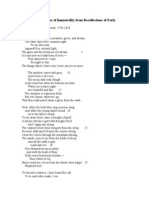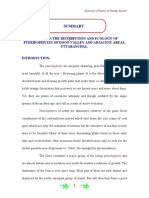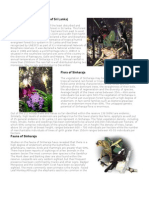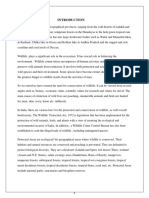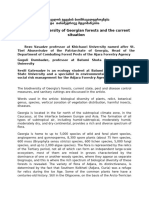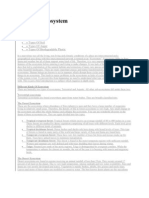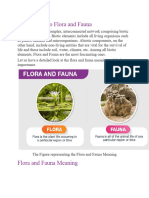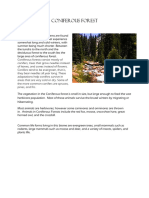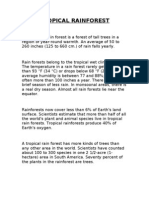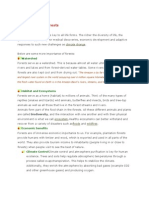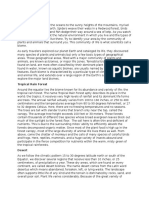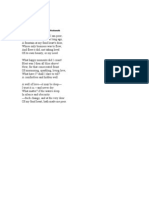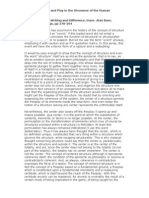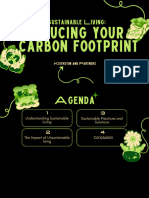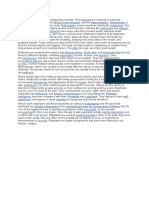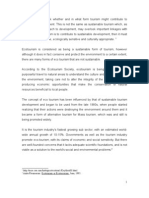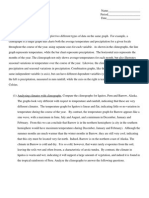Biodiversity and Ecological Status of Iringole Kavu
Biodiversity and Ecological Status of Iringole Kavu
Uploaded by
Pramod Enthralling EnnuiCopyright:
Available Formats
Biodiversity and Ecological Status of Iringole Kavu
Biodiversity and Ecological Status of Iringole Kavu
Uploaded by
Pramod Enthralling EnnuiOriginal Description:
Original Title
Copyright
Available Formats
Share this document
Did you find this document useful?
Is this content inappropriate?
Copyright:
Available Formats
Biodiversity and Ecological Status of Iringole Kavu
Biodiversity and Ecological Status of Iringole Kavu
Uploaded by
Pramod Enthralling EnnuiCopyright:
Available Formats
BIODIVERSITY AND ECOLOGICAL STATUS OF IRINGOLE KAVU-A SACRED GROVE AT ERNAKULAM DISTRICT IN KERALA
(Dr. Aji. C. Panicker, Asst. Professor, Dept. Of Zoology, Mar Athanasius College, Kothamangalam, Kerala-686666)
EXECUTIVE SUMMARY
Iringole kavu, a miniature forest, is located in Perumbavoor of Ernakulam District, Kerala. The total area of the Kavu is about 110 acres. It lies at 100 10 North latitude and 760 30east latitude. The climate is hot and humid so that a very rich flora and fauna include valuable herbs; medicinal plants, monkeys, squirrel and mynah are seen in the region. The verities of birds presence are also an added attraction. Sacred groves are patches of natural vegetation surviving in the man-modified landscapes. Sacred groves are often the only lingering samples of natural vegetation in the man-modified landscapes of Kerala. In most localities, sacred groves are being increasingly exposed to various kinds of threats leading to either qualitative degradation or total disappearance. Sacred groves are good refuge for different kinds of plants and animals. There are about 722 plant species belonging to 474 genera and 129 families in sacred groves of Kerala. Out of 722 species, 154 are endemic to Western Ghats and 459species contain one or more medicinal properties. Allmost all sacred groves are home for a large number of vertibrates, especially spiders, amphibians, lizards, birds and mammals. The area has a tropical humid climate. The hot season extends from March to the end of May. This is followed by the southwest monsoon, which continues up to August. The northeast monsoon, which follows, extends from October up to December. During hot season, the mean daily maximum temperature is about 35 C. The average minimum temperature is around 20 C. during December-January. Occasionally night temperature may go down to 16 C. Annual rainfall is 34.38 mm. More than 80 percent of it occurs during the period of southwest monsoon. The area receives 68 percent of rain in July. The vegetation of the sacred grove may be classified as canopy and subcanopy layers composed of both evergreen and deciduous tree species formed a continuous dense layer, which 82 major species of 34 families. The common tree species found in the sacred grove are Tectona grandia, Hopea ponga, Ficus benghalensis, Ficus religiosa, Holigarna arnottiana, Mangifera indica, Plumeria rubra, Strychnos nuxvomica, Mimusops eleng and Xanthoxylum rhetsa. Orchid flora comprise of very common species like Acampe praemorsa and Bulbophyllum neilgherrense. A large climber which is common in semievergreen forest, Raphidophora pertusa, small evergreen tree, Naringi crenulata, a rare medicinal plant Morinda umbellate, an endemic species Loesneriella arnottiana are the other plant species growing in the grove. These species are known to develop high profile humidity in the surroundings that promote luxurious growth of vegetation. Medicinal plants like Sida acuta, Piper longum, Morinda unbellata, Remustatia vivipara, Cyathula prostrata, Gloriosa superba, Ipomoea sepiarea, Ipomoea
digitata, Naraveilia zeylanica, Salacia reticulata, Sarcostigma klenii, and Tinospora cordifolia are very common in this grove.The floristic diversity is of the grove includes Hopea ponga is the dominant tree species. The three strata of trees, shrubs and herbs, climbers and stragglers, epiphytes and parasites are the floristic elements of a grove. This stratification is prominent in groves like Kammadam and Aravanchal. Here the upper canopy includes trees with straight and slender trunk and branches are produced at the top. The common species include, woody climbers like Calicopteris floribunda, Dalbergia horrida var horrida, Gnetum ula strychnos aenea etc. The animals identified from the sacred grove are of two types, those which inhabits the groves like Hares, Squirrels, bats, birds(19 species), lizards(5 species), frogs, and other lower group of organisms like butterflies(22species), dragon flies, damsel flies, moths, spiders(8 species) beetles, bugs, wasps, mole crickets, grasshoppers, millipedes(3 Arthrosphaera sp.), centipedes, scorpions, snails, slugs (Arion sp.) and different types of ants. Some of the members of the avian fauna who nests and dens in the grove and those who visits the grove temporarily for food and shelter are the added attraction to the diversity. Sacred groves act as an abode for many rare, endemic, endangered species and economically important plants of fruit bearing and medicinal properties. Apart from conserving biological diversity, this sacred grove that is situated in the middle of the human habitation are responsible for conserving water table of the soil. This is evident from the perennial nature of ponds, wells and tanks, which are situated in the nearby areas of the sacred groves. The fertility of the agro-ecosystems is very high due to the humus and nutrients generated in the sacred groves. The water quality of the grove has an average hydrobiological parameter. The pH of water has an average of 5.6, i.e. the water has an acidic character. The turbidity has an average of 52.5. The TDS has an average of 38.5. All the other parameters like Nitrate, Phosphate, Alkalinity, Dissolved Organic matter etc. show some slight variations. The phosphate content shows gradual decrease and is favorable for the growth of plankton. It also helps to maintain the water table of the nearby areas. It plays a very important role in maintaining the cool and humid climatic condition in the grove. The Sacred groves also serve as a meaningful fusion of religion and ecology. The protection, preservation and conservation of these species through sacred grove is a way of celebrating the sanctity of life.
Flora of Iringole Kavu
Flourishing flora
Trees of Iringole kavu
Fauna of Iringole kavu
Water sources of the sacred grove
You might also like
- Ode Intimations of Immortality From Recollections of Early ChildhoodDocument5 pagesOde Intimations of Immortality From Recollections of Early ChildhoodPramod Enthralling EnnuiNo ratings yet
- Postcolonial Reading of Blood DiamondDocument15 pagesPostcolonial Reading of Blood DiamondPramod Enthralling EnnuiNo ratings yet
- Indulekha (First Novel of Malayalam) PDFDocument210 pagesIndulekha (First Novel of Malayalam) PDFMunniNo ratings yet
- Site AnalysisDocument18 pagesSite AnalysisOvang SugiantariNo ratings yet
- Sanjay Gandhi National Park Project NotesDocument15 pagesSanjay Gandhi National Park Project NotessrishNo ratings yet
- Wildlife & BiodiversityDocument15 pagesWildlife & BiodiversitySachinNo ratings yet
- Biodiversity in The Western Ghats An Information KitDocument134 pagesBiodiversity in The Western Ghats An Information KitNeil AgshikarNo ratings yet
- Studies On The Distribution and Ecology of Pteridophytes of Doon Valley and Adjacent Areas, UttaranchalDocument17 pagesStudies On The Distribution and Ecology of Pteridophytes of Doon Valley and Adjacent Areas, Uttaranchalsameer82786No ratings yet
- 8123Document6 pages8123bharatNo ratings yet
- Research Work: Ma. Christina Julia de Guzman VI-CharityDocument9 pagesResearch Work: Ma. Christina Julia de Guzman VI-CharityChristina de GuzmanNo ratings yet
- Sinharaja (Vergin Rain Forest of Sri Lanka)Document2 pagesSinharaja (Vergin Rain Forest of Sri Lanka)Mohan Perera100% (6)
- UntitledDocument20 pagesUntitledEmilda SaraNo ratings yet
- flora and faunaDocument23 pagesflora and faunarudrapratap.apsr712No ratings yet
- EnamDocument8 pagesEnamzahid HassanNo ratings yet
- Ecology Project Group 3Document58 pagesEcology Project Group 3MntesnotNo ratings yet
- Ncert-Science and Social Science (9TH Class)Document11 pagesNcert-Science and Social Science (9TH Class)akulasowjanya574No ratings yet
- სლოვენია EnglishDocument9 pagesსლოვენია Englishsesili gatenadzeNo ratings yet
- Field Study Tour - Yamuna Biodiversity Park - Brocvhure and Instructions - Format For ReportDocument8 pagesField Study Tour - Yamuna Biodiversity Park - Brocvhure and Instructions - Format For Reportaditya doneriaNo ratings yet
- Chapter 05 Natural Vegetation and Wildlife 1715920793Document31 pagesChapter 05 Natural Vegetation and Wildlife 1715920793Brijnandan KumarNo ratings yet
- The Amazon A Tropical RF Grade 3-5Document18 pagesThe Amazon A Tropical RF Grade 3-5api-242138155No ratings yet
- NATURAL VEGETATION ^0 WILDLIFE BY ABHAY_021127Document28 pagesNATURAL VEGETATION ^0 WILDLIFE BY ABHAY_021127rubyo2833No ratings yet
- Rainforests in IndiaDocument6 pagesRainforests in IndiaSPREAD RED DGPNo ratings yet
- President Ramon Magsaysay State University: Chapter 2. The Evolution of EcosystemsDocument6 pagesPresident Ramon Magsaysay State University: Chapter 2. The Evolution of EcosystemsKipi Waruku BinisutiNo ratings yet
- Rainforests 1Document8 pagesRainforests 1Sadia RehanNo ratings yet
- DeforestationDocument4 pagesDeforestationRoscela Mae D. ArizoNo ratings yet
- Geography-Natural-vegetation-and-wildlifeDocument3 pagesGeography-Natural-vegetation-and-wildlifeanisha.uj1810No ratings yet
- A Study On Local BiodiversityDocument18 pagesA Study On Local Biodiversitysagaransari558No ratings yet
- Have You Ever Wondered WhatDocument5 pagesHave You Ever Wondered Whatapi-287350577No ratings yet
- Natural Ecosystems in The PhilippinesDocument3 pagesNatural Ecosystems in The PhilippinesJelian ReyesNo ratings yet
- Tropical Evergreen Forests Are A Dominant Part of The Natural Vegetation in IndiaDocument13 pagesTropical Evergreen Forests Are A Dominant Part of The Natural Vegetation in IndiaPARDEEP RATHINo ratings yet
- The Different Types of EcosystemsDocument5 pagesThe Different Types of EcosystemsShayNo ratings yet
- Ecosystem - Major Types 2024Document3 pagesEcosystem - Major Types 2024Sheryn Mae GalendezNo ratings yet
- Forest EcosystemDocument12 pagesForest EcosystemAlysa Shereen Alba FerrierNo ratings yet
- Types of EcosystemDocument2 pagesTypes of EcosystemNikhil ThakurNo ratings yet
- Types of EcosystemDocument17 pagesTypes of EcosystemJayashwa Singh ChauhanNo ratings yet
- Heritage Trees of PondicherryDocument6 pagesHeritage Trees of PondicherryV.SUNDARARAJUNo ratings yet
- Unit-3-Eco Succession-Ecosystems PDFDocument31 pagesUnit-3-Eco Succession-Ecosystems PDFAnunanda VijayanNo ratings yet
- L-4 Indian Flora and FaunaDocument9 pagesL-4 Indian Flora and FaunaKhushi KotwaniNo ratings yet
- Rain ForestDocument2 pagesRain ForestAnwar AbdulkadirNo ratings yet
- The Interactions in The Ecosystem Grafe 6Document57 pagesThe Interactions in The Ecosystem Grafe 6Julie Mae Sajulga JacobeNo ratings yet
- Habitat DescriptionsDocument7 pagesHabitat Descriptionsannaauburn0No ratings yet
- Orchids PDFDocument16 pagesOrchids PDFMathew Joel MathewNo ratings yet
- Tropical Rain ForestDocument28 pagesTropical Rain Forestmehsa001No ratings yet
- Importance of ForestsDocument8 pagesImportance of Forestsonelbabalcon100% (1)
- CH 17 Forest Our LifelineDocument25 pagesCH 17 Forest Our Lifelinesujeet Kumar SinghNo ratings yet
- Types of Eco SystemDocument3 pagesTypes of Eco SystemGagandeep SinghNo ratings yet
- Hiba Firoos Roll No.13. S4 B BatchDocument11 pagesHiba Firoos Roll No.13. S4 B BatchHiba 111No ratings yet
- Different Types of EcosystemsDocument3 pagesDifferent Types of EcosystemsCherry Brutas0% (1)
- ADITYA - Types of EcosystemDocument51 pagesADITYA - Types of EcosystemAakash YadavNo ratings yet
- Biodiversity 1Document14 pagesBiodiversity 1Prabhat Kusum PandaNo ratings yet
- Makalah Tropical Rain ForestDocument14 pagesMakalah Tropical Rain Forestgentong_cantikNo ratings yet
- Biomes of Our EarthDocument5 pagesBiomes of Our EarthMayaNo ratings yet
- Project Report For Environmental Studies PaperDocument6 pagesProject Report For Environmental Studies PaperNuman KabirNo ratings yet
- Ecosystem structureDBITAMKB PDFDocument8 pagesEcosystem structureDBITAMKB PDFSnehal KoliNo ratings yet
- Eco & BioDocument42 pagesEco & BioMalki NavodyaNo ratings yet
- Heritage Trees-SOFCON Rarest Trees Found in YercaudDocument6 pagesHeritage Trees-SOFCON Rarest Trees Found in YercaudV.SUNDARARAJU100% (1)
- 6-Types of EnvironmentDocument49 pages6-Types of EnvironmentFatimaNo ratings yet
- Kaziranga National ParkDocument13 pagesKaziranga National ParkRadhika AgarwalNo ratings yet
- Erythrina Fusca Loureiro.: January 1997Document6 pagesErythrina Fusca Loureiro.: January 1997afiqNo ratings yet
- Natural Vegetation and Wildlife blogDocument11 pagesNatural Vegetation and Wildlife blogMadhukar PalliNo ratings yet
- Unit-6 Biodiversity ConservationDocument17 pagesUnit-6 Biodiversity Conservationinsha moquitNo ratings yet
- Natural Vegetation and Wildlife QADocument3 pagesNatural Vegetation and Wildlife QAbkmohanty0005No ratings yet
- BiogeographyDocument39 pagesBiogeographypramilayadavpuruliaNo ratings yet
- Crow's Last StandDocument1 pageCrow's Last StandPramod Enthralling EnnuiNo ratings yet
- Your Attention PleaseDocument2 pagesYour Attention PleasePramod Enthralling EnnuiNo ratings yet
- Poem in OctoberDocument4 pagesPoem in OctoberPramod Enthralling EnnuiNo ratings yet
- Sonnet 45 of ShakespeareDocument1 pageSonnet 45 of ShakespearePramod Enthralling EnnuiNo ratings yet
- A Complaint: by William WordsworthDocument1 pageA Complaint: by William WordsworthPramod Enthralling EnnuiNo ratings yet
- But Do Not So, I Love Thee in Such Sort, As Thou Being Mine, Mine Is Thy Good ReportDocument1 pageBut Do Not So, I Love Thee in Such Sort, As Thou Being Mine, Mine Is Thy Good ReportPramod Enthralling EnnuiNo ratings yet
- Sonnet 32Document1 pageSonnet 32Pramod Enthralling EnnuiNo ratings yet
- Faith" Is Fine InventionDocument1 pageFaith" Is Fine InventionPramod Enthralling EnnuiNo ratings yet
- Out of The Cradle Endlessly RockingDocument5 pagesOut of The Cradle Endlessly RockingPramod Enthralling EnnuiNo ratings yet
- Frost at MidnightDocument3 pagesFrost at MidnightPrakash0% (1)
- Ode Intimations of ImmortalityDocument5 pagesOde Intimations of ImmortalityPramod Enthralling EnnuiNo ratings yet
- A Narrow Fellow in The GrassDocument1 pageA Narrow Fellow in The GrassPramod Enthralling EnnuiNo ratings yet
- A Slumber Did My Spirit SealDocument1 pageA Slumber Did My Spirit SealPramod Enthralling EnnuiNo ratings yet
- Rava Kesari Recipe - IngredientsDocument1 pageRava Kesari Recipe - IngredientsPramod Enthralling EnnuiNo ratings yet
- That Time of Year Thou Mayst in Me BeholdDocument1 pageThat Time of Year Thou Mayst in Me BeholdPramod Enthralling EnnuiNo ratings yet
- Porattu NadakamDocument31 pagesPorattu NadakamPramod Enthralling Ennui25% (4)
- Kerala Style Aviyal: Ingredients NeededDocument1 pageKerala Style Aviyal: Ingredients NeededPramod Enthralling EnnuiNo ratings yet
- Structure, Sign, and Play in The Discourse of The Human SciencesDocument14 pagesStructure, Sign, and Play in The Discourse of The Human SciencesPramod Enthralling EnnuiNo ratings yet
- Climate Change - SummaryDocument3 pagesClimate Change - SummaryDianne MendozaNo ratings yet
- Brown and Green Scrapbook Sustainability and Ecology PresentationDocument14 pagesBrown and Green Scrapbook Sustainability and Ecology PresentationAdwoa Biama Ofosu-BoatengNo ratings yet
- Safe Harbor Management Agreement For Urban Florida Burrowing Owls in Marco Island FloridaDocument16 pagesSafe Harbor Management Agreement For Urban Florida Burrowing Owls in Marco Island FloridaOmar Rodriguez OrtizNo ratings yet
- Food Chain & SymbiosisDocument15 pagesFood Chain & SymbiosisJerryNo ratings yet
- Unit 1 - The Natural WorldDocument12 pagesUnit 1 - The Natural WorldLinh ChiNo ratings yet
- Anvaya Cove BrochureDocument12 pagesAnvaya Cove BrochureanvayacovepropertiesNo ratings yet
- Eating The Earth - How Your Diet Could Change The WorldDocument16 pagesEating The Earth - How Your Diet Could Change The WorldVegan Future100% (1)
- GGSIPU Reserved ParkDocument5 pagesGGSIPU Reserved ParkIron AdiNo ratings yet
- Geography Forest and WildlifeDocument17 pagesGeography Forest and Wildlifemydelightedlife0% (1)
- Unesco Green Academies: Guidelines For Climate-Resilient BuildingsDocument20 pagesUnesco Green Academies: Guidelines For Climate-Resilient BuildingsFD OriaNo ratings yet
- Elephants Are The Largest Existing Land Animals. ThreeDocument1 pageElephants Are The Largest Existing Land Animals. ThreeCristi CrissNo ratings yet
- Conceptual FrameworkDocument1 pageConceptual Frameworkjek vinNo ratings yet
- Completion Analytical Exposition TextDocument2 pagesCompletion Analytical Exposition TextKaito Ryo ShinNo ratings yet
- Diversity Garcinia Species in The Western Ghats. Phytochemical PerspectiveDocument218 pagesDiversity Garcinia Species in The Western Ghats. Phytochemical Perspectivepilisanta100% (1)
- Ceam Principles, Processes, and Practices: Environmental Impact Assessment PP-1Document10 pagesCeam Principles, Processes, and Practices: Environmental Impact Assessment PP-1Anonymous Z2pby9SqlHNo ratings yet
- Environmental Impact Assessment in Oil and Gas ExploitationDocument14 pagesEnvironmental Impact Assessment in Oil and Gas Exploitation78arthur100% (1)
- Ecotourism: Is It Sustainable?Document10 pagesEcotourism: Is It Sustainable?AnnMirelNo ratings yet
- Science 8: Quarter 4 - Module 10 Impact of Human in An EcosystemDocument19 pagesScience 8: Quarter 4 - Module 10 Impact of Human in An EcosystemNOVA LESLIE AGAPAYNo ratings yet
- SUSTAINDocument54 pagesSUSTAINMarilyn GenoveNo ratings yet
- CooksoniaDocument6 pagesCooksoniaSanket PunyarthiNo ratings yet
- Evaluation of AIDocument257 pagesEvaluation of AIcmukasaukNo ratings yet
- Unit 8.3 HandoutDocument5 pagesUnit 8.3 HandoutAbraham L ALEMUNo ratings yet
- Bats As BioindicatorsDocument14 pagesBats As BioindicatorsSpurthi AcharamNo ratings yet
- Reaction PaperDocument3 pagesReaction Paper한니옐0% (1)
- Learning Journey Teacher HandbookDocument10 pagesLearning Journey Teacher Handbookapi-307961766No ratings yet
- A Visit To The ZooDocument4 pagesA Visit To The Zoohijab habibNo ratings yet
- B.ing Kelompok 3 XII IPS 4Document44 pagesB.ing Kelompok 3 XII IPS 4Ridho RizaldiNo ratings yet
- Climograph WorksheetDocument6 pagesClimograph Worksheetanon_254999660No ratings yet
- .Uksample Papers and Mark Schemes2021novemberAQA 80351 QP NOV21 PDFDocument36 pages.Uksample Papers and Mark Schemes2021novemberAQA 80351 QP NOV21 PDFHitdifferentszaa LoveNo ratings yet
